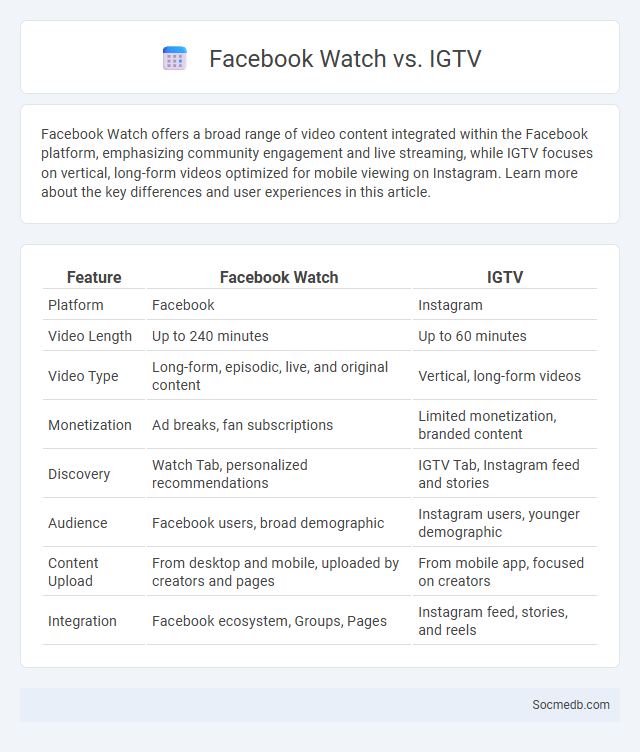
Photo illustration: Facebook Watch vs IGTV
Facebook Watch offers a broad range of video content integrated within the Facebook platform, emphasizing community engagement and live streaming, while IGTV focuses on vertical, long-form videos optimized for mobile viewing on Instagram. Learn more about the key differences and user experiences in this article.
Table of Comparison
| Feature | Facebook Watch | IGTV |
|---|---|---|
| Platform | ||
| Video Length | Up to 240 minutes | Up to 60 minutes |
| Video Type | Long-form, episodic, live, and original content | Vertical, long-form videos |
| Monetization | Ad breaks, fan subscriptions | Limited monetization, branded content |
| Discovery | Watch Tab, personalized recommendations | IGTV Tab, Instagram feed and stories |
| Audience | Facebook users, broad demographic | Instagram users, younger demographic |
| Content Upload | From desktop and mobile, uploaded by creators and pages | From mobile app, focused on creators |
| Integration | Facebook ecosystem, Groups, Pages | Instagram feed, stories, and reels |
Introduction: Evolution of Social Video Platforms
Social video platforms have rapidly evolved from simple sharing sites like YouTube, launched in 2005, to sophisticated ecosystems including TikTok and Instagram Reels, specializing in short-form, user-generated content. These platforms leverage advanced algorithms and AI-driven personalization to maximize user engagement and content discoverability. The continuous innovation in video formats and interactive features has transformed social media into a dynamic space for entertainment, brand marketing, and influencer culture.
Facebook Watch: Key Features and Audience
Facebook Watch offers an extensive library of videos, including original shows, live streams, and user-generated content tailored to various interests and demographics. Its key features include personalized recommendations, Watch Parties for shared viewing experiences, and interactive elements such as polls and live comments that boost audience engagement. By leveraging Facebook's vast user base, your content can reach a diverse and active global audience seeking entertainment, community, and real-time interaction.
IGTV: Instagram’s Long-Form Video Platform
IGTV, Instagram's long-form video platform, allows users to upload videos up to 60 minutes, enhancing content depth beyond typical Instagram posts. Designed for mobile viewing, IGTV supports vertical and horizontal formats, optimizing user engagement and viewing experience. Brands and creators leverage IGTV to deliver tutorials, interviews, and series, driving higher reach and audience retention on Instagram.
Watch: Defining the Competitor(s)
Watch allows you to monitor competitors' social media strategies by analyzing their content engagement, follower growth, and posting frequency. Tracking these metrics helps identify trends and gauge your competitors' audience preferences in real time. Leveraging this data enables you to refine your social media approach and maintain a competitive edge.
Content Creation: Tools and Monetization
Content creation on social media thrives through tools like Adobe Creative Cloud, Canva, and video editing apps such as Final Cut Pro and InShot, enabling high-quality visuals and engaging multimedia. Monetization opportunities include brand partnerships, sponsored posts, affiliate marketing, and platforms like YouTube AdSense or Patreon, allowing creators to earn revenue directly from their audience. By leveraging these resources, you can optimize your content strategy and maximize your social media income potential.
User Engagement and Interaction Metrics
User engagement on social media platforms is measured through interaction metrics such as likes, comments, shares, and click-through rates, which indicate the level of audience involvement with your content. Monitoring these metrics allows you to understand user behavior, optimize content strategies, and boost overall reach and visibility. Enhancing engagement not only increases brand awareness but also fosters a loyal community around your social media presence.
Algorithm and Content Discovery
Social media algorithms analyze user behavior, preferences, and engagement patterns to personalize content discovery, boosting user retention and satisfaction. These data-driven algorithms prioritize relevant posts, advertisements, and trending topics, ensuring users receive tailor-made feeds that increase interaction rates. Advanced recommendation systems on platforms like Facebook, Instagram, and TikTok utilize machine learning models to optimize content visibility and maximize time spent on the app.
Audience Demographics and Reach
Social media platforms attract diverse audience demographics, with age groups ranging from Gen Z to Baby Boomers, each exhibiting unique engagement patterns and content preferences. Understanding these demographics allows businesses to tailor marketing strategies and optimize ad targeting to enhance reach, engagement, and conversion rates. Platforms like Facebook, Instagram, TikTok, and LinkedIn provide detailed analytics tools, enabling precise audience segmentation and maximizing campaign effectiveness across various social and professional networks.
Pros and Cons Comparison Table
Social media offers significant benefits such as enhanced connectivity, real-time information sharing, and widespread marketing opportunities, boosting Your personal and business engagement. However, it also poses risks including privacy concerns, misinformation spread, and potential mental health issues. Comparing these pros and cons in a table highlights clear trade-offs, helping You make informed decisions about your social media use.
Future Trends and Platform Potential
Emerging technologies such as artificial intelligence and augmented reality are set to revolutionize social media platforms by delivering hyper-personalized content and immersive user experiences. Platforms like TikTok and Instagram are expanding their e-commerce capabilities, enabling seamless social shopping and influencer marketing integration. The rise of decentralized social networks promises enhanced user privacy and data control, challenging traditional centralized platforms like Facebook and Twitter.
 socmedb.com
socmedb.com